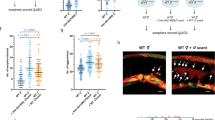Abstract
Pherophorins are extracellular matrix (ECM) glycoproteins fromVolvox that share homology with the sex-inducing pheromone. A novel pherophorin (pherophorin III) was characterized both with respect to expression pattern and proteolytic processing in vivo. Furthermore, it was shown that the pherophorins represent a protein family of ECM glycoproteins exhibiting a modular composition: their N-terminally located domain is a homolog of a domain found in the ECM glycoprotein SSG 185. Together with SSG 185, pherophorin I is a main component of the cellular zone within the ECM. TheVolvox genome contains a tandem arrangement of genes encoding pherophorin II-related polypeptides. Inhibition of proteolytic processing of pherophorin II and III in vivo appears to result in the suppression of sexual induction.
Similar content being viewed by others
Abbreviations
- ECM:
-
extracellular matrix
- PCR:
-
polymerase chain reaction
- RACE:
-
rapid amplification of cDNA ends
References
Adair, A.J., Appel, H. (1989) Identification of a highly conserved hydroxyproline-rich glycoprotein in the cell walls ofChlamydomonas reinhardtii and two other Volvocales. Planta179, 381–386
Bonner, W.M., Laskey, R.A. (1974) A film detection method for tritium labeled proteins and nucleic acids in polyacrylamide gels. Eur. J. Biochem.46, 83–88
Ertl, H. (1989) Die molekulare Struktur eines polymeren, hydroxyprolinreichen Glykoproteins aus der extrazellulären Matrix vonVolvox carteri. PhD Thesis, University of Regensburg, Germany
Ertl, H., Mengele, R., Wenzl, S., Engel, J., Sumper, M. (1989) The extracellular matrix ofVolvox carteri: Molecular structure of the cellular compartment. J. Cell Biol.109, 3493–3501
Ertl, H., Hallmann, A., Wenzl, S., Sumper, M. (1992) A novel extensin that may organize extracellular matrix biogenesis inVolvox carteri. EMBO J.11, 2055–2062
Frischauf, A.-M., Lehrach, H., Poustka, A., Murray, N. (1983) Lambda replacement vectors carrying polylinker sequences. J. Mol. Biol.170, 827–842
Frohman, M.A., Dush, M.K., Martin, G.R. (1988) Rapid production of full-length cDNAs from rare transcripts: Amplification using a single gene-specific oligonucleotide primer. Proc. Natl. Acad. Sci. USA85, 8998–9002
Gilles, R., Bittner, C., Jaenicke, L. (1981) Site and time of formation of the sex-inducing glycoprotein inVolvox carteri. FEBS Lett.124, 57–61
Gilles, R., Gilles, C., Jaenicke, L. (1983) Sexual differentiation of the green algaeVolvox carteri: Involvement of extracellular phosphorylated proteins. Naturwissenschaften70, 571–572
Gilles, R., Gilles, C., Jaenicke, L. (1984) Pheromone-binding and matrix-mediated events in sexual induction ofVolvox carteri. Z. Naturforsch.39c, 584–592
Gueltekin, H., Heermann, K. (1988) The use of polyvinylidenedefluoride membranes as a general blotting matrix. Anal. Biochem.172, 320–329
Hager, D.A., Burgess, R.R. (1980) Elution of proteins from sodium dodecyl sulfate-polyacrylamide gels, removal of sodium dodecyl sulfate, and renaturation of enzymatic activity: Results with sigma subunit ofEscherichia coli RNA polymerase, wheat germ DNA topoisomerase, and other enzymes. Anal. Biochem.109, 76–86
Hallmann, A., Sumper, M. (1994a) An inducible arylsulfatase ofVolvox carteri with properties suitable for a reporter-gene system. Purification, characterization and molecular cloning. Eur. J. Biochem.221, 143–150
Hallmann, A., Sumper, M. (1994b) Reporter genes and highly regulated promoters as tools for transformation experiments inVolvox carteri. Proc. Natl. Acad. Sci. USA91, 11562–11566
Harlow, E., Lane, D. (1988) Antibodies: A laboratory manual, Cold Spring Harbor Laboratory Press, Cold Spring Harbor, New York
Kirk, D.L., Birchem, R., King, N. (1986) The extracellular matrix ofVolvox: A comparative study and proposed system of nomenclature. J. Cell Sci.80, 207–231
Mages, H.-W., Tschochner, H., Sumper, M. (1988) The sexual inducer ofVolvox carteri. Primary structure deduced from cDNA sequence. FEBS Lett.234, 407–410
Mort, A.J., Lamport, D.T.A. (1977) Anhydrous hydrogen fluoride deglycosylates glycoproteins. Anal. Biochem.82, 289–309
Provasoli, L., Pintner, I.J. (1959) Artificial media for freshwater algae: Problems and suggestions. In: The ecology of algae. Special publication No. 2, Pymatuning laboratory of field biology, pp. 84–96, Tyron, C.A., Hartman, R.T., eds. University of Pittsburgh, Pittsburgh, PA
Sambrook, J., Fritsch, E.F., Maniatis, T. (1989) Molecular Cloning: A laboratory manual, Cold Spring Harbor Laboratory Press, Cold Spring Harbor, New York
Sanger, F., Nicklen, S., Coulson, A.R. (1977) DNA sequencing with chain-terminating inhibitors. Proc. Natl. Acad. Sci. USA74, 5463–5467
Schiedlmeier, B., Schmitt, R., Müller, W., Kirk, M.M., Gruber, H., Mages, W., Kirk, D.L. (1994) Nuclear transformation ofVolvox carteri. Proc. Natl. Acad. Sci. USA91, 5080–5084
Schmitt, R., Fabry, S., Kirk, D.L. (1992) In search of molecular origins of cellular differentiation inVolvox and its relatives. Int. Rev. Cytol.139, 189–265
Starr, R.C., Jaenicke, L. (1974) Purification and characterization of the hormone initiating sexual morphogenesis inVolvox carteri f. nagariensis Iyengar. Proc. Natl. Acad. Sci. USA71, 1050–1054
Sumper, M., Berg, E., Wenzl, S., Godl, K. (1993) How a sex pheromone might act at a concentration below 10−16 M. EMBO J.12, 831–836
Tschochner, H., Lottspeich, F., Sumper, M. (1987) The sexual inducer ofVolvox carteri: Purification, chemical characterization and identification of its gene. EMBO J.6, 2203–2207
Wenzl, S., Sumper, M. (1986) Early events of sexual induction inVolvox: Chemical modification of the extracellular matrix. Dev. Biol.115, 119–128
Author information
Authors and Affiliations
Additional information
We wish to thank Dr. R. Deutzmann (Universität Regensburg, Germany) for sequencing peptides. This work was supported by the Deutsche Forschungsgemeinschaft (SFB43).
Rights and permissions
About this article
Cite this article
Godl, K., Hallmann, A., Rappel, A. et al. Pherophorins: a family of extracellular matrix glycoproteins fromVolvox structurally related to the sex-inducing pheromone. Planta 196, 781–787 (1995). https://doi.org/10.1007/BF01106774
Received:
Accepted:
Issue Date:
DOI: https://doi.org/10.1007/BF01106774




